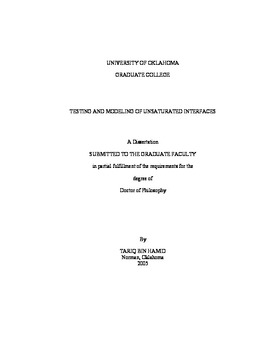| dc.contributor.advisor | Miller, Gerald A., | en_US |
| dc.contributor.author | Hamid, Tariq Bin. | en_US |
| dc.date.accessioned | 2013-08-16T12:19:45Z | |
| dc.date.available | 2013-08-16T12:19:45Z | |
| dc.date.issued | 2005 | en_US |
| dc.identifier.uri | https://hdl.handle.net/11244/844 | |
| dc.description.abstract | A conventional fully automated direct shear test device was modified to achieve the objectives of this study. The newly developed device, called the Unsaturated Interface Direct Shear Apparatus (UIDSA), was equipped for applying and maintaining suction as well as net normal stress. The UIDSA can be used to conduct constant water content and constant suction tests on unsaturated soil and unsaturated interfaces. | en_US |
| dc.description.abstract | The performance of the newly developed device was checked and effects of net normal stress, suction, and roughness were investigated. Net normal stresses of 105, 140, and 210 kPa were used and were conducted under constant suction values of 20, 50, and 100 kPa. | en_US |
| dc.description.abstract | An existing elastoplastic constitutive model was modified to predict the behavior of interfaces between unsaturated soil and steel. The model is applicable for the constant net normal and constant suction conditions. Model parameters are function of net normal stress, suction, and surface roughness. Predictions made with the modified elastoplastic model agreed well with the experimental results. | en_US |
| dc.description.abstract | Results presented in this study suggest that the maximum shear stress of interfaces between unsaturated soil and steel is a function of net normal stress and suction. As net normal stress and suction increased, so did the shear strength. The results of this study indicate that matric suction contributed to the peak shear strength of unsaturated interfaces; however, residual shear strength did not vary with the matric suction. As opposed to the matric suction, variation in net normal stress affected both peak and residual shear stress. The influence of matric suction was more pronounced in soil than interfaces. Similar to soil samples, the rough interface showed increase in dilatancy with increase in suction, whereas the smooth interface did not show dilatancy behavior. | en_US |
| dc.description.abstract | Major device modifications included the construction of an air pressure chamber and testing cells for holding soil and counterfaces, addition of high air entry porous stones, addition of a pore water and pore air control system, and other modifications to accommodate the new apparatus. For saturated soil testing, a High Air Entry Porous Disk (HAEPD) was fixed in the bottom half of the shear box, whereas for interface testing the HAEPD was fixed in the top platen and was placed on top of the soil during testing. | en_US |
| dc.description.abstract | The extended Mohr-Coulomb failure criterion provided a good model for describing variation in interface shear strength as a function of net normal stress and matric suction. Shear strength parameters for soil and interfaces were determined to define the extended Mohr-Coulomb failure envelope. | en_US |
| dc.description.abstract | Research was conducted at the University of Oklahoma to examine the behavior of interfaces in unsaturated soil. The objectives of this research were to: (1) design and construct an apparatus for testing unsaturated interfaces and soil; (2) test unsaturated soil and interfaces in the new device to study the strength and volumetric behavior of unsaturated soil and interfaces; (3) examine application of the Mohr-Coulomb failure criterion to unsaturated interfaces; and (4) develop an elastoplastic model to account for the effect of suction and net normal stress on the behavior of an unsaturated interface. | en_US |
| dc.format.extent | xx, 288 leaves : | en_US |
| dc.subject | Engineering, Civil. | en_US |
| dc.subject | Soil-structure interaction. | en_US |
| dc.subject | Shear strength of soils. | en_US |
| dc.subject | Soils. | en_US |
| dc.title | Testing and modeling of unsaturated interfaces. | en_US |
| dc.type | Thesis | en_US |
| dc.thesis.degree | Ph.D. | en_US |
| dc.thesis.degreeDiscipline | School of Civil Engineering and Environmental Science | en_US |
| dc.note | Source: Dissertation Abstracts International, Volume: 66-01, Section: B, page: 0424. | en_US |
| dc.note | Adviser: Gerald A. Miller. | en_US |
| ou.identifier | (UMI)AAI3162838 | en_US |
| ou.group | College of Engineering::School of Civil Engineering and Environmental Science | |
